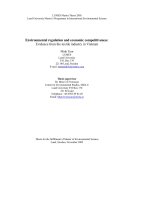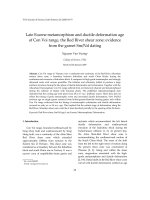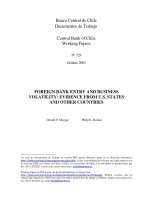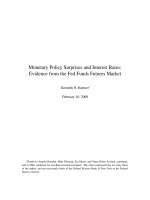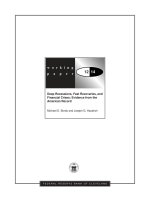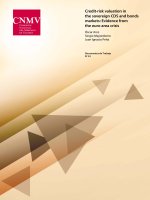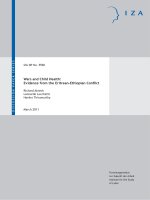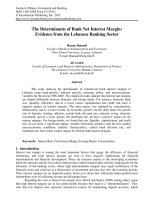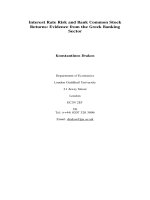Forecasting stock return volatility: Evidence from the west African regional stock market
Bạn đang xem bản rút gọn của tài liệu. Xem và tải ngay bản đầy đủ của tài liệu tại đây (710.58 KB, 11 trang )
Journal of Applied Finance & Banking, vol. 5, no. 6, 2015, 25-35
ISSN: 1792-6580 (print version), 1792-6599 (online)
Scienpress Ltd, 2015
Forecasting Stock Return Volatility: Evidence from the
West African Regional Stock Market
N’dri Konan Léon1
Abstract
This paper compares the out-of-sample forecasting performance of the GARCH, EGARCH,
and GJR-GARCH models across the Normal distribution, Student-t distribution, and
Generalized Error Distribution (GED) in the regional stock market of the West African
Economic and Monetary Union called the BRVM. The study uses weekly returns ranging
from 4 January 1999 to 10 March 2005 for in-sample estimation of conditional variance
models, and the period from 11 March 2005 to 29 July 2005 for out-of-sample forecasting.
Using the RMSE and MAE as measures of forecasting accuracy, I find that the EGARCH
model outperforms both the GARCH and the GJR-GARCH models under the Student-t
distribution and the GED.
JEL classification numbers: C22, C53
Keywords: Volatility models, Volatility forecasts, BRVM, forecasting performance.
1
Introduction
Forecasting the volatility of financial time series has been extensively examined over the
past three decades. Theory predicts that accurate estimation and forecast of the volatilities
of asset prices would have important implications for investments, security valuation, risk
management, and monetary policy making. Volatility is a major input to investments
decisions and portfolio selection since a good forecast of the volatility of asset prices over
the investment holding period is the starting point for assessing investment risk. Volatility
plays a central role in option pricing as the knowledge of the volatility of the underlying
asset is mandatory to price such a derivative. Since the first Basle Accord in 1996, volatility
forecasting in terms of value-at-risk has been compulsory for most financial institutions.
Finally, policy makers rely on market estimates of volatility as a barometer for the
UFR des Sciences Economiques et de Gestion, Université Félix Houphouet Boigny, Cocody. BPV
43 Abidjan, Côte d’Ivoire. Tel.: +225 0761 0329.
1
Article Info: Received : August 2, 2015. Revised : August 31, 2015.
Published online : November 1, 2015
N’dri Konan Léon
26
vulnerability of financial markets and the economy in handling monetary policy.
Despites their importance, empirical studies on forecasting and measuring the performance
of volatility have largely been carried out on developed stock markets (Hansen, 1994;
Gokcan, 2000; Awartini and Corradi, 2005; Bae et al., 2007; Bali, 2007; Chuang et al.,
2007; Curto et al., 2009; Liu and Hung, 2010 amongst others), and on emerging stock
markets (Sandoval, 2006; Komain, 2007; Hien, 2008; Kovacic, 2008; Lee, 2009; Shamiri
and Isa, 2009; Su, 2010 for example). Studies on African stock markets have been however
limited (Appiah and Menyah, 2003; Ogun et al., 2005; Eskandar, 2005; Alagidede and
Panagiotidis, 2009), and inexistent for the regional stock market of West Africa. The
present study fills this gap and contributes to the existing empirical literature by examining
the forecasting of volatility and their performance in the BRVM using various conditional
volatitlity models and different loss functions. My results show that the EGARCH model,
in-sample and out-of-sample, outperforms both the GARCH and the GJR-GARCH models
under the Student-t distribution and the GED.
The rest of the paper is organized as follows. After the introduction section, an overview of
the BRVM is provided by section 2. Section 3 presents the research methodology. Section
4 exposes the empirical results and their analysis and section 5 concludes the paper.
2
The Regional Stock Market of West Africa
The regional stock exchange of West Africa, known as the Bourse Régionale des Valeurs
Mobilières (hereafter, BRVM), was established on 18 December 1996, and began its
operations on 16 September 1998. It is the stock exchange of the West African Economic
and Monetary Union (WAEMU). The BRVM is responsible for organizing the securities
market and distributing related information. To that end, it guarantees the listing of
securities on the exchange, the quotation of securities, the publication of market prices and
information, the promotion and development of the securities exchange.
The BRVM is headquartered in Abidjan, Côte d’Ivoire, and represented in every member
state by a national branch office charged with: 1) overseeing public relations for the
exchange and the central clearing house; 2) disseminating market information; 3) assisting
brokerage firms and other market stakeholders; 4) organizing local promotion of the
regional exchange. At its inception, the BRVM has two sections for stocks and a single
section for bonds with eligibility conditions differing across sections. A company seeking
to be listed on the BRVM must satisfy the following conditions: 1) be incorporated; 2) sign
a written agreement to publishing the annual statements in the official newsletter, and to
participate in the organization of the exchange; 3) sign a written agreement to obey the rules
and regulations of the BRVM; 4) to apply for listing on the BRVM, the candidate company
must mandate a brokerage firm to assist and advise it.
The BRVM is a centralized spot exchange driven by orders, that is, the price of a security
is fixed by matching bid and ask orders. The quotation is done by fixing, that is, a single
price is obtained by matching bid and ask orders. Currently, there are five sessions a week.
Two BRVM market indices represent the activities of stock market shares: the BRVM
Composite comprises all securities listed on the exchange, and the BRVM 10 is composed
of the ten most active companies on the exchange. As of 17 March 2006, 39 companies are
listed on the BRVM.
Formulation and selection criteria for the BRVM indexes are based on the leading global
market indexes, especially, the FCG index of the International Finance Corporation, a
Forecasting Stock Return Volatility in the West African Regional Stock Market
27
World Bank affiliate. The formulation of the indexes takes into account market
capitalization, transaction per session, and transaction frequency. Only common shares are
used to calculate the indexes. The indexes are automatically generated by the BRVM
trading system and circulated after every session. The BRVM 10 is reviewed four times a
year, and the BRVM Composite after every new listing.
Table 1 below shows some performance indicators of the BRVM from 31 December 2002
to 29 July 2005. This table reflects the high performance of the BRVM 10 and shows how
volatile the regional stock market is.
Table 1: Selected Figures Of The BRVM
Capitalization
31/12/ 2002
31/12/ 2003
31/12/ 2004
29/07/ 2005
BRVM 10
465 634 264 590
617 337 595 495
607 239 551 350
766 467 440 025
BRVM Composite
832 398 094 700
858 140 223 580
1 005 047 884 085
1 094 198 936 835
BRVM 10
10
10
10
10
BRVM Composite
39
39
39
39
4823
2994
2031
1033
Number of firms
Some measures
Volume traded of stocks
Value traded (CFAfr)
171 254 520
72 584 325
35 861 220
47 493 520
30
85
28
25
9
15
8
8
# of transations
# of securities traded
3
Research Methodology
This section describes the data, exposes the volatility models, and presents the forecasting
accuracy measures.
3.1 Sample Data and their Properties
The data set used in this study is weekly closing prices on the BRVM 10 index obtained
from the Official Newsletter of the Regional Stock Market (BRVM). The choice of the
BRVM 10 over the BRVM Composite is motivated by two reasons: first, it is composed of
the ten most actively traded stocks in the BRVM and second, it accounts for about 70% of
the total market capitalization of the BRVM as shown in Table 1 above. The study period
ranges from 4 January 1999 to 29 July 2005. The period from 4 January 1999 to 10 March
2005 is used for estimation purposes and, the period from 11 March 2005 to 29 July 2005
is used for out-of-sample evaluation or forecasting. I compute the continuously
compounded weekly stock market returns, Rt , as follows:
Rt 100*ln( Pt / Pt 1 )
(1)
N’dri Konan Léon
28
Where Pt is the value of the BRVM 10 price index for the period t , and t represents
time in weeks. Pt 1 is BRVM 10 index price for period t 1 ; ln(.) is the logarithm
operator. All returns are expressed in local currencies and are not adjusted for dividends.
Table 2 below reports summary statistics of weekly stock market returns.
Table 2: Summary statistics
Series
BRVM10
T
Mean
SD
Skewness
Kurtosis
J.B.
ARCH(5)
741
0.027
0.810
-0.758
16.409
5621*
19.611*
(0.000)
(0.001)
Notes: T is the number of observations; SD is the standard deviation; * means significant at 5%. JB is the Jarque-Bera statistic;
ARCH(5) is the ARCH test for homoskedasticity with 5 lags; p-values are in parentheses.
The mean and the standard deviation are 0.072 and 1.636 respectively. The skewness
statistic of 0.930 shows that the distribution is positively skewed relative to the normal
distribution (0 for the normal distribution). This is an indication of a non symmetric series.
The kurtosis is very much larger than 3, the kurtosis for a normal distribution. This suggests
that for the BRVM, large market surprises of either sign are more likely to be observed, at
least unconditionally. The Ljung-Box test statistics Q (.) and Q 2 (.) provide tests for the
absence of autocorrelation and homoscedasticity, respectively. The significance values of
Q statistics indicate significant serial correlation in the mean return series. This suggests
that the inclusion of a lag dependent variable in the mean equation is appropriate. Strong
autocorrelation is also detected in the squared mean returns as shown by the values of the
Q 2 (.) . It results in volatility clustering in the distribution of stock market returns. In
addition, the Jarque-Bera normality test rejects the hypothesis of normality.
3.2 Volatility Models
Since the seminal of work of Engle (1982) on conditional volatility, conditional
heteroskedastic models have become the main statistical instruments to estimate and
forecast asset returns volatility. I present in this section, the three different models used to
evaluate the predictive power of volatility models in the BRVM. The models presented here
are all variant of the Autoregressive Conditional Heteroskedasticity (ARCH) of Engle
(1982).
3.2.1 The GARCH Model
The ARCH model developed by Engle (1982) estimates the variance of returns as a simple
quadratic function of the lagged values of innovations but exhibits weaknesses as it requires
many parameters and a high order of lagged values to capture the volatility process.
Bollerslev (1986) and Taylor (1986) remedy to these weaknesses by proposing the
Generalized Autoregressive Conditional Heteroskedasticity (GARCH) model that has an
infinite ARCH specification and allows the reduction of the number of parameters to be
estimated by imposing nonlinear restrictions. In the GARCH model, the conditional
variance of a variable is dependent upon previous lags of the squared residual from the
Forecasting Stock Return Volatility in the West African Regional Stock Market
29
mean equation and present news about the volatility from the previous period. The GARCH
models just as the ARCH model, captures the two characteristics of financial time series:
Volatility clustering that occurs when large changes tend to be followed by large changes
and small changes tend to be followed by small changes (Mandelbrot, 1963); leptokurtosis
which describes the fact that the distribution of their returns is fat-tailed, that is the kurtosis
of the distribution exceeds the kurtosis of a standard Gaussian distribution.
In order to expose the GARCH model, I exploit the ARCH technology. I consider:
Rt Rt 1 t
(2)
Where Rt is the continuously compounded return defines in equation 1; is the
constant term; is a coefficient; t is the disturbance or unpredictable part with mean
0 and variance t2 ; the conditional variance is defined as:
t2 var( Rt t 1 )
(3)
Where Rt is defined as above; t 1 is the set of all available information at time t-1;
var(.) is the variance operator. The volatility measure defined by the conditional variance
is in an expectation formulation. The Autoregressive Conditional Heteroskedasticity
(ARCH) process of Engle (1982) is defined as:
q
t2 0 i t2i
(4)
i 1
q refers to the order of the lagged squared returns included in the model; 0 ; i 0 .
The Generalized ARCH model, GARCH (p,q) of Bollerslev (1986) and Taylor (1986) is
expressed as follows:
q
p
i 1
j 1
t2 0 i t2i j t2 j
(5)
2
In this equation, t i refers to past innovations and t2 j is about past variances. In
order to have a positive value, a sufficient condition for the conditional variance bears on
its parameters as follows: 0 ; i 0 , and j 0 . The GARCH (p, q) is weakly
stationary if and only if
q
i 1
i j 1 j 0 . The model keeps not only the volatility
p
clustering and the leptokurtosis characteristics of the ARCH model but it is also a linear
function of lagged conditional variances. The GARCH model is therefore an extension of
the ARCH model.
3.2.2 EGARCH Model
The GARCH model takes into account the time series characteristics of volatility clustering
and leptokurtosis but fails to consider the leverage effects first documented by Black (1976).
N’dri Konan Léon
30
To remedy that, Nelson (1991) proposes the Exponential GARCH (EGARCH). This model,
a refinement of the GARCH model imposes a non negativity constraint on market variance,
and allows for the conditional variance to respond to asymmetrically to return innovations
of different signs (leverage effect). I specify the EGARCH model as follows:
q
p
ln t2 0 j ln t2 j i t i E t i
t i
j 1
i 1
t i
p t i
i
i 1 t i
(6)
Where 0 , j , i , and i are parameters. ln t2 is the one-period ahead volatility
forecast. This implies that the leverage effect is exponential rather than quadratic and
forecast of conditional variance are guaranteed to be non-negative; 0 is the mean level;
j represents the persistence parameter; ln t2 j is the past period variance. Unlike the
GARCH model, the EGARCH model allows for leverage. If i is negative, leverage
effect exists. That is an unexpected drop in price (bad news) increases predictable volatility
more than an unexpected increase in price (good news) of similar magnitude (Black, 1976;
Christie, 1982). If i is positive, then the conditional volatility tends to rise (fall) when
the absolute value of the standardized residuals is larger (smaller).
3.2.3 The GJR Model
A main limitation of the GARCH model is its failure to capture asymmetries in financial
time series. It considers mainly that negative and positive shocks have the same effects on
volatility. To remedy that and take into account the volatility clustering and the
leptokurtosis characteristics of returns, Glosten, Jagananthan and Runkle (1993) extend the
GARCH model with an additional term to account for asymmetries. This model known as
the GJR-GARCH model is expressed as follows:
q
p
i 1
j 1
t2 0 i t2i i t2i dt i j t2 j
(7)
Where dt i is a dummy variable with:
dt i 1 if t i bad news
0 if t i 0, good news
Good news is shown in the model by i whereas bad news is shown by i i . In
addition, when i 0 , leverage effect exists. Non negativity condition is satisfied by
0 0 , i 0 , j 0 and i i 0 .
3.3 Out-of-Sample Forecasts Performance
In order to evaluate the forecasting performance of the above conditional variance models,
I compute two measures: the Root Mean Squared Error (RMSE) and the Mean Absolute
Error (MAE). Assuming that the forecast sample is j=T+1, T+2, …….T+h, and denote the
actual and forecasted value in period t as yt and yˆt respectively, the reported forecast
Forecasting Stock Return Volatility in the West African Regional Stock Market
31
error statistics are computed as follows:
T+h
yˆ y
RMSE =
t
t
2
h
t=T+1
T+h
MAE =
yˆt yt h
t=T+1
4
Empirical Results and Analysis
In order to assess the forecasting performance of equations (5), (6), and (7), I estimate each
of them jointly with equation (2) upon specifying the assumptions about the distribution of
error terms. With the aim to compare the models, I consider three density functions: the
Normal distribution, the Student-t distribution, and Generalized Error Distribution (GED).
The two later are expected to reduce the excess kurtosis and skewness displayed by the
residuals of the conditional heteroskedasticity models. All models are estimated by
maximum likelihood method. The nonlinearity in the equations imposes an iterative method
to find the parameters. I adopt the Berndt, Hall, Hall, and Hausman (BHHH) method. The
use of the BHHH algorithm requires the log-likelihood for a single observation. I estimate
all models considering p=q=1; the models become:
GARCH (1, 1):
t2 0 1 t21 1 t21
t 1
2
t 1
t 1
t 1
t2 0 1 t21 1 t21 t21 dt 1
EGARCH (1, 1): ln t2 0 1 ln t21 1
GJR- GARCH (1, 1):
(8)
(9)
(10)
All parameters are defined as in section 3.2. Table 3 below shows Estimates of GARCH
(1,1) ; EGARCH (1,1), and GJR-GARCH (1,1) under Normal Distribution, Student-t
Distribution, and GED.
N’dri Konan Léon
32
Table 3: Estimates of GARCH (1,1) ; EGARCH (1,1), and GJR-GARCH (1,1) under
Normal Distribution, Student-t Distribution, and GED.
𝜇
𝜌
𝛼0
𝛼1
𝛽1
𝛾
AIC
SC
Log lik.
Normal distribution
GAR
EGA
GJR
0.014
0.045
0.060
(0.789)
(0.441)
(0.326)
0.331*
0.284*
0.321*
(0.000)
(0.000)
(0.000)
0.643*
-0.288*
0.497*
(0.000)
(0.006)
(0.001)
0.501*
0.585*
0.664*
(0.002)
(0.000)
(0.010)
0.243*
0.700*
0.421*
(0.041)
(0.000)
(0.000)
0.244*
-0.5911*
(0.012)
(0.026)
3.327
3.285
3.301
3.386
3.356
3.372
-525
-518
-520
Student-t distribution
GAR
EGA
GJR
-0.004
0.007
0.019
(0.940)
(0.901)
(0.727)
0.262*
0.278*
0.286*
(0.000)
(0.000)
(0.000)
0.804*
-0.313*
0.550*
(0.030)
(0.002)
(0.015)
0.667*
0.676*
0.780*
(0.039)
(0.000)
(0.027)
0.234*
0.743
0.425*
(0.077)
(0.000)
(0.000)
0.267*
-0.667*
(0.011)
(0.047)
3.197
3.175916
3.187121
3.268
3.258537
3.269742
-503
-499
-501
GAR
-0.046
(0.308)
0.274*
(0.000)
0.662
(0.003)
0.515*
(0.003)
0.227
(0.132)
3.186
3.257
-502
GED
EGA
-0.036
(0.449)
0.291*
(0.000)
-0.321*
(0.000)
0.599*
(0.000)
0.724*
(0.000)
0.227*
(0.023)
3.168
3.250
-498
GJR
0.016
(0.871)
0.401*
(0.000)
1.442
(0.181)
0.111*
(0.056)
0.488
(0.212)
-0.200*
(0.061)
3.667
3.749
-577
Notes: This table reports estimates of the three conditional variance models under the Normal and Student t distributions, and the
GED. GAR, EGA, and GJR are the GARCH (1,1), EGARCH (1,1), and GJR-GARCH (1,1) respectively. AIC is the Akaike info
criterion; SC is the Schwarz criterion, and Log lik. is the Log likelihood function. The p-values are in parentheses. * denotes
significance at the 5 percent level.
The persistence parameters 1 from Table 3 are only significant for the EGARCH. They
are 0.700, 0.743, and 0.724 for the Normal and Student-t distributions, and GED
respectively. This suggests that the degree of persistence is high and close to one. In other
words, once volatility increases, it is likely to remain high over several periods. The positive
and statistically significant coefficient 1 in all models confirms the presence of clustering,
that is, conditional volatility tends to rise (fall) when the absolute value of the standardized
residuals is larger (smaller). The coefficients are all negative and significant in the
GJR-GARCH model thereby implying that leverage effect exists, that is, an unexpected
drop in price (bad news) increases predictable volatility more than an unexpected increase
in price (good news) of similar magnitude. On the other hand, the coefficients are
positive and statistically significant for the GARCH model thereby indicating the presence
of asymmetries, that is, volatility is higher during market booms than when market declines.
From this discussion, it appears that considering the models, the EGARCH seems to better
estimates the series as shown by its high log-likelihood and low Akaike information
criterion. When I consider the densities, the Student-t distribution outperforms the Gaussian
and the GED for its log-likelihood is higher than that of other distributions.
I conduct a diagnostic check to ascertain whether the models are fairly specified. Table 4
below shows the diagnostic tests for the standardized residuals, squared standardized
residuals, and the skewness and kurtosis of the standardized residuals.
Forecasting Stock Return Volatility in the West African Regional Stock Market
33
Table 4: Diagnostic checks
Mean
GARCH(1,1)
EGARCH(1,1)
Normal Student-t GED
Normal Student-t GED
0.016
0.027 0.064656 -0.0190
0.0145
0.052
GJR-GARCH(1,1)
Normal Student-t GED
-0.018
0.011
0.046
S. D
1.001
0.892
1.000190
1.000
0.938
1.001
1.001
0.922
1.144
Skewness
0.164
0.174
0.140245
0.044
0.047
0.029
0.002
-0.014
6.515
Kurtosis
5.293
5.358
5.319396
5.299
5.606
5.462
5.288
5.366
84.100
Q(6)
5.897
(0.435)
8.5676
(0.199)
8.1440
0.228
7.065
(0.315)
6.594
(0.360)
6.4396
(0.376
4.894
(0.557)
6.290
(6.290)
4.182
0.652)
Q(20)
26.029
(0.165)
28.110
(0.107)
27.672
0.117
24.215
(0.233)
19.250
(0.377)
24.112
(0.238
22.617
(0.308)
24.000
(0.242)
9.760
0.972)
Q2(6)
6.396
(0.380)
7.3321
(0.291)
7.4138
0.284
3.9839
(0.679)
3.9354
(0.685)
4.132
(0.659)
3.944
(0.684)
4.1990
(0.650)
0.542
0.997)
Q2(20)
12.331
(0.904)
12.684
(0.854)
13.260
0.866
12.209
(0.909)
11.855
(0.921)
11.868
(0.921
11.532
(0.931)
11.918
(0.919)
0.772
1.000)
J.B.
71.308
(0.000)
75.54705
(0.000)
72.54952
0.000000
70.375
(0.000)
90.448
(0.000)
80.674
(0.000)
69.576
(0.000)
74.409
(0.000)
89680
0.000)
Notes: This table containssummary statistics from the three conditional variance models above. The
Ljung-Box test statistics for
the standardized residuals, and the standardized residuals squared at slag6 and 20 are also provided. The p-values are in
parentheses.
The kurtosis is around 5 for all models across all densities except for the GJR-GARCH (1,1)
under the GED, which is quite an improvement from the raw series (7.63). Furthermore,
the skewness is close to zero for all models across all densities but GJR-GARCH (1,1)
under the GED. The Q-statistics for the absence of autocorrelation in the standardized
residuals have p-values ranging from 0.435 to 0.972 across all densities against 0.000 for
the raw series. This is a seal of absence of autocorrelation. The p-values of the Q2-statistics
for the absence of heteroskedasticity range from 0.380 to 1.000 across all densities relative
to 0.000 in the original series. It suggests that there is absence of heteroskedasticity. The
results above suggest that the models are fairly specified and can therefore be used for
forecasting purposes. I conduct in the next paragraphs, the static out-of-sample forecast.
The results are shown in Table 5 below.
Table 5: Out-of-Sample Forecasting Performance
Normal Distribution
Student-t Distribution
GED
GARCH
EGARCH
GJRGARCH
GARCH
EGARCH
GJRGARCH
GARCH
EGARCH
GJRGARCH
RMSE
2.234
2.291
2.329
2.335
2.309*
2.294
2.330
2.302*
2.777
MAE
1.455
1.477
1.510
1.504
1.490*
1.482
1.510
1.493*
1.732
Note: RMSE is the Root Mean SquaredError and MAE is Mean Absolute Error;* denotes here the good performance of the
EGARCH model under the Student
-t distribution and the GED.
Two measures of forecasting accuracy, the roots mean square error (RMSE) and the mean
absolute error (MAE) are used. Apart from the Normal distribution, the EGARCH model
systematically outperforms all the GARCH and GJR-GARCH under the Student-t
N’dri Konan Léon
34
distribution and the GED by yielding smaller RMSE and MAE. Furthermore, the
improvement in the log-likelihood function shown in Table 3 corroborates this finding. The
EGARCH model does a better job in describing the data under study and can therefore be
used for forecasting purposes.
5
Conclusion
This study has addressed the issues of the forecasting performance of conditional volatility
models in the regional stock market of the West African Economic and Monetary Union
called the BRVM. I compare the forecasting performance of GARCH, EGARCH, and
GJR-GARCH models across the Normal distribution, Student-t distribution, and
Generalized Error Distribution (GED). My in-sample estimations reveals that the EGARCH
model does a better job in describing the data than others; my out-of-sample forecasts using
the RMSE and MAE as measures of forecasting accuracy, show that the EGARCH model
outperforms both the GARCH and the GJR-GARCH models under the Student-t
distribution and the GED. This finding could have implications for market analysts. They
would find it useful to use EGARCH models and non-Normal densities to estimate
securities’ volatilities with the aim to design volatility timing strategies.
References
[1]
B. E. Hansen, Autoregressive conditional density estimation, International Economic
Review, 35, (1994), 705–730.
[2] S. Gokcan, Forecasting volatility of emerging stock market: linear versus nonlinear
GARCH models, Journal of Forecasting, 19, (2000), 499-504.
[3] B.M.A. Awartani and V. Corradi, Predicting the volatility of the S&P-500 stock via
GARCH models: the role of asymmetries, International Journal of Forecasting, 21,
(2005), 167-183.
[4] J. Bae, C.J. Kim and C.R. Nelson, Why are stock returns and volatility negatively
correlated?, Journal of Applied Finance, 14, (2007), 41-58.
[5] T.G. Bali, Modeling the dynamics of interest rate volatility with skewed fat-tailed
distribution, Annals of Operations Research, 151, (2007), 151-178.
[6] Y. Chuang, J.R. Lu and P.H. Lee, Forecasting volatility in the financial markets: a
comparison of alternative distributional assumptions, Applied Financial Economics,
17, (2007), 1051-1060.
[7] J.D. Curto and J. C. Pinto, Modeling stock markets’volatility using GARCH models
with Normal, Student’s t and stable Paretian distributions, Statistical Papers, 50,
(2009), 311-321.
[8] H.C. Liu and J.C. Hung, Forecasting S&P-100 stock index volatility: The role of
volatility asymmetry and distributional assumption in GARCH models, Expert
Systems with Applications, 37, (2010), 4928-4934.
[9] J. Sandoval, Do asymmetric GARCH models fit better exchange rate volatilities on
emerging markets?, (2006). />[10] J. Komain, Behavior of stock market index in the stock exchange of Thailand, NIDA
Economics Review, 2, (2007), 47-57.
Forecasting Stock Return Volatility in the West African Regional Stock Market
35
[11] M.T.T. Hien, Modelling and forecasting volatility By Garch-Type Models: The Case
Of Vietnam Stock Exchange, PhD thesis, University Nottingham, (2008).
[12] Z. J. Kovacic, Forecasting volatility: Evidence from the Macedonian stock exchange,
International Research Journal of Finance and Economics, 18, (2008), 182–212.
[13] H. J. Lee, Forecasting performance of asymmetric GARCH stock market volatility
models, Journal of International Economic Studies, 13(2), (2009), 109–142.
[14] Shamiri, A. and Z. Isa, “Modeling and forecasting volatility of Malaysian stock
markets,” Journal of Mathematics and Statistics, 3, (2009), 234-240.
[15] C. Su, Application of EGARCH model to estimate financial volatility of daily returns:
The empirical case of China, University of Gothenburg, Master Degree Project No.
2010:142, (2010).
[16] J. Appiah-Kusi and K. Menyah, Return predictability in African stock markets,
Review of Financial Economics, 12, (2003), 247-270.
[17] G. Ogum, F. Beer and G. Nouyrigat, Emerging Equity Market Volatility An Empirical
Investigation of Markets on Kenya and Nigeria, Journal of African Business, 6: 1/2,
(2005), 139 – 154.
[18] T. Eskandar, Modeling and Forecasting Egyptian Stock Market Volatility Before and
After Price Limits, Working Paper # 0310, The Economic Research Forum,
September, (2005).
[19] P. Alagidede and T. Panagiotidis, Modelling stock returns in Africa’s emerging equity
markets, International Review of Financial Analysis, 18, (2009), 1-11.
[20] R.F. Engle, Autoregressive conditional heteroskedasticity with estimates of the
variance of U.K. Inflation, Econometrica, 50, (1982), 987-1007.
[21] T. Bollerslev, Generalized autoregressive conditional heteroskedasticity, Journal of
Econometrics, 31, (1986), 307-321.
[22] S.J. Taylor, Modelling Financial Time Series, John Wiley&Sons, Chichester, (1986).
[23] B. Mandelbrot, The variation of certain speculative prices, Journal of Business, 36(4),
(1963), 394–419.
[24] F. Black, Studies of stock price volatility changes, (1976), 177–181, Proceedings of
the 1976 Business Meeting of the Business and Economics Statistics Section.
American Statistical Association, Washington, DC.
[25] D.B. Nelson, Conditional heteroskedasticity in asset returns: A new approach,
Econometrica, 59(2), (1991), 347–370.
[26] A.A. Christie, The Stochastic behavior of common stock variances-value, leverage
and interest rate effects, Journal of Financial Economics, 10(4), (1982), 407–432.
[27] L.R. Glosten, R. Jagannathan and D.E. Runkle, On the relation between expected
value and the volatility of the normal excess return on stocks, Journal of Finance, 48,
(1993), 1779-1801.
